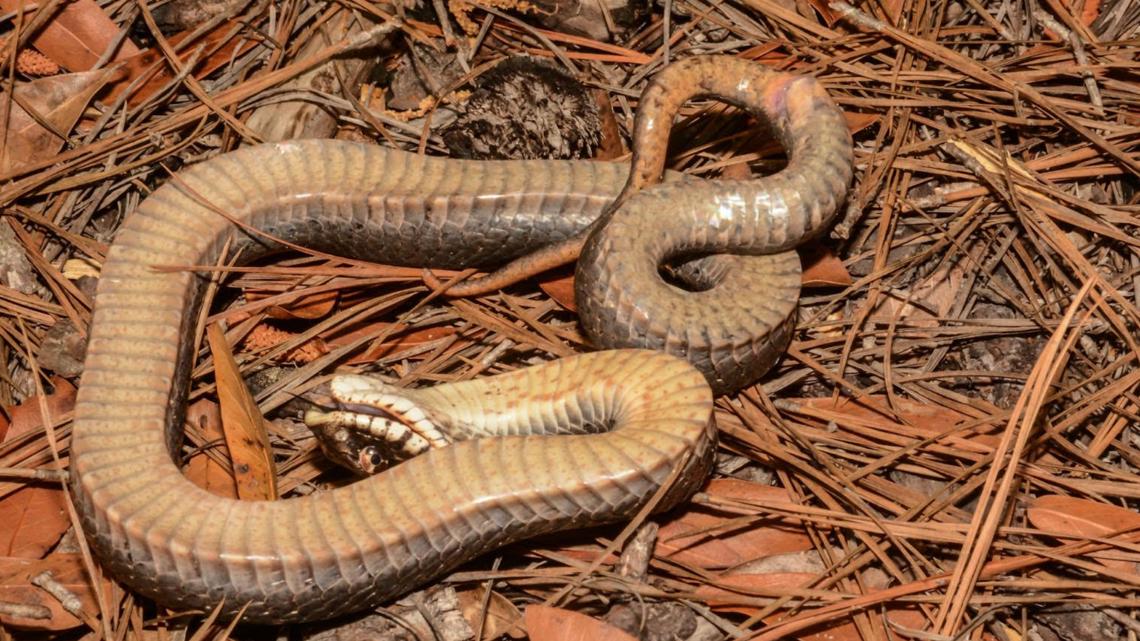ARKANSAS, USA — Temperatures are warming up, and people are getting out in droves to access the many hiking trails, bikeways, and other outdoor offerings across the Natural State.
However, people aren't the only thing getting out into nature to soak up the sun — the snakes are out too. The Arkansas Game and Fish Commission (AGFC) says that one harmless snake in particular may spook some because of its resemblance to a deadly predator.
The eastern hognose snake can be found all across Arkansas in localized populations. The snake is described as medium-sized and stocky with an upturned snout. It comes in a variety of colors, including tan, olive, yellow, black, gray, reddish-orange, or a combination of those colors with different patterns.
However, the hognose will almost always have a pair of large, dark brown or black blotches behind its head, AGFC said.
The snake is also known as the “puff adder” and “hissing viper.”
AGFC says that while the snake is harmless, its cobra-like appearance, paired with a "theatrical performance [that] may cause your heart to skip a beat," may make some Arkansans stop in their tracks.


"Snakes scare a lot of people. According to Web MD, half of the people in the world feel anxious about snakes while 2 to 3% of people experience ophidiophobia — a fear of snakes so extreme that it interferes with life," the AGFC said in a release.
The hognose prefers a habitat with sandy or loose soil, where it can dig and poke through in pursuit of its favorite food, toads, whose typical defenses are neutralized by the snake.
"Toads have dandy defense mechanisms for most predators — glands behind each eye secrete a toxin that makes them inedible, and they puff up their bodies to appear much larger," AGFC said. "These defenses are no match for the hognose. A neutralizing enzyme in the digestive tract of the snake allows it to eat toads with no ill effect, and a specialized pair of large teeth in the upper jaw in the back of the mouth deflate a toad like a balloon."
Additionally, the hognose produces a mild venom in its saliva that subdues prey.
The snakes also eat frogs, salamanders, lizards and their eggs, ground-nesting bird eggs, and small mammals such as mice and shrews, according to AGFC.
As for defense, the hognose puts on a "thespian-worthy performance" when frightened, according to AGFC.
"Act one involves the snake flattening its head and neck and hissing loudly. It may even strike, but only as a bluff with its mouth closed," AGFC explained. "If this offensive display doesn’t work to ward off an enemy, the snake’s second act is a strong defense. It may go into convulsions, open its mouth and let its tongue hang out, thrash around, throw up prey from its stomach, defecate, roll onto its back and play dead. If the perceived threat moves away, the snake will eventually roll over onto its belly, look about cautiously while flicking its tongue before slithering away to safety."
The commission explains that hognose snakes are typically not aggressive, despite the look and the show, and that instances of the snakes biting people are rare. The venomous saliva has little effect on humans and if there is swelling or tingling, it's usually not for long.
The performance, however, can cause them to be killed by humans out of unwarranted fear, AGFC said.
Watch 5NEWS on YouTube.
Download the 5NEWS app on your smartphone:
Stream 5NEWS 24/7 on the 5+ app: How to watch the 5+ app on your streaming device
To report a typo or grammatical error, please email KFSMDigitalTeam@tegna.com and detail which story you're referring to.

